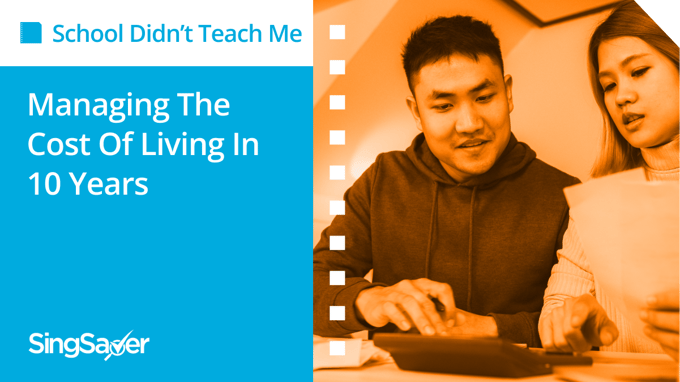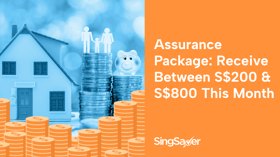Formal education may give us a leg up in life and career, but less so on managing money. School Didn’t Teach Me, a SingSaver series, is your informal education in personal finance.
As one of the most expensive cities in the world, how will inflation impact the cost of living in Singapore in 10 years? We attempt to take a peek into the future, by using inflation data from the past.
When I was barely old enough to start attending school, I came across a photo of a Lamborghini. Right there and then, I decided that I’d grow up, get a job and buy that very car.
Unfortunately, reality caught up with me in my early 20s after stepping into the working world. In fact, I sometimes found myself struggling to scrape together enough change for a taxi ride home. And with that, my dreams of affording a supercar or even a plain old regular car faded.
Similarly, I realised that things were expensive and would only worsen as time went by. This lesson is another one of those things that they didn’t teach me in school.
But this time, I don’t blame them—parents don’t usually like it when teachers traumatise their children with the cruel truths of life. Besides, there’d be plenty of time to develop crippling existential dread in adulthood.
And as the saying goes, ‘forewarned is forearmed’, which means we can always prepare ourselves by learning from the past, right?
With that said, we’ll be attempting to determine the cost of living in Singapore in 10 years. And to help us along, we’ll be referring to historic inflation figures.
Now, whatever forecasts or figures that we arrive at regarding the prices of things 10 years later is, at best, an educated guess. It’s simply impossible to make any surefire predictions because nobody can foretell the future.
Still, as failable as they may be, projections are still useful in helping us get a heads-up into what may come. That’s why some of the smartest people work in data science and statistics.
So, with the loud and clear understanding that your mileage may vary, let’s dive in to see what the numbers could look like in future.
How much will average prices rise in 10 years?
To take a peek into the future, we first have to look back into the past. Specifically, we will be using the inflation rate to help us determine how much prices could rise in 10 years.
In case you didn’t know, the inflation rate is an indication of how prices have risen or fallen compared to the preceding period of measure. It is calculated based on several metrics, such as cost of housing, food, transport and other common expenditures.
Here’s a table of Singapore’s inflation rate over the past 10 years. We’ve also calculated the average yearly rate at the end.
| Year | Inflation rate % |
| 2021 | 1.56 |
| 2020 | -0.18 |
| 2019 | 0.57 |
| 2018 | 0.44 |
| 2017 | 0.58 |
| 2016 | -0.53 |
| 2015 | -0.52 |
| 2014 | 1.03 |
| 2013 | 2.36 |
| 2012 | 4.58 |
| Yearly average | 0.989 |
Using the 10-year period from 2012 to 2021, we arrive at an average inflation rate of 0.989% per year.
What you would have noticed, however, is that the inflation rate recorded for a particular year could be very far off from this average. In some years, the inflation rate was well over 1%, while in others, inflation actually turned negative.
This volatility reflects a correlation between Singapore’s economy and global macroeconomic conditions; one example is the shrinkage in inflation in 2020 as the COVID-19 pandemic swept the world.
Hence, assuming that inflation continues at an average yearly rate of 0.989%, we can calculate how much higher prices will be in 10 years with the help of a compound interest calculator.
Here are the results.
| Rate of inflation | 0.989% |
| Cost in 2021 | S$100 |
| Cost after 10 years | S$110.35 |
| Increase in dollars | S$10.35 |
| Increase in percentage | 10.35% |
Going by the calculation above, you’ll need to spend 10.35% more per dollar in 10 years’ time to receive the same amount of goods, products or services as in 2021.
Does the average inflation rate tell the whole story?
Well, no.
A country’s inflation rate considers the prices of stuff that people spend on, which, as you can imagine, can consist of tens of thousands of products, items and services.
Different types of goods also increase or decrease at different rates, so the headline inflation rate is hardly a homogenous measure.
Instead, we can achieve a more nuanced view of things by investigating the inflation rate of major spending categories such as food, housing and education.
How much is food expected to cost in 10 years?
From 1962 to 2020, food costs in Singapore rose by an average of 2.86% per year.
This low rate can be corroborated by the abundant options of cheap and delicious food available to us here, even as indulgences such as artisanal coffee, speciality cakes and bubble tea continue to grow in popularity, despite easily costing more than a hawker centre meal.
Assuming the rate of food inflation holds to this figure, we can estimate the cost of food in 10 years, as follows:
| Rate of inflation | 2.86% |
| Cost in 2021 | S$100 |
| Cost after 10 years | S$132.58 |
| Increase in dollars | S$32.58 |
| Increase in percentage | 32.58% |
Based on projections, it looks like food prices will rise by almost a third in 10 years. By then, Starbucks drinks with double-digit prices will be the norm rather than the exception.
How much is education expected to cost in 10 years?
Measured from 2001 to 2021, the cost of education saw an increase of 3.15% on average from year to year. If this rate holds steady, we could be seeing education costs rise even faster than that of food.
Once again, using the same calculation method, here’s how much the price of education could rise in 10 years time.
| Rate of inflation | 3.15 |
| Cost in 2021 | S$100 |
| Cost after 10 years | S$136.36 |
| Increase in dollars | S$36.36 |
| Increase in percentage | 36.36% |
A 36% rise is not inconsequential, especially considering that course fees at tertiary institutions already cost several thousands after subsidies at present.
How much is housing expected to cost in 10 years?
Now, for housing costs, some analysts have observed an increase of 12.45% over a 10-year period.
This is not a 12.45% increase every year; rather, it’s simply the difference between housing costs from Year 1 to Year 10. Hence, this simplifies our calculations here.
Once more, assuming this increase also holds true 10 years in the future, we will derive the following:
| Change after 10 years | +12.45% |
| Cost in 2021 | S$100 |
| Cost after 10 years | S$112.45 |
This figure may not seem that bad, But when applied to a real-life scenario, that S$1 million shoebox condominium unit will cost you an extra S$112,450 in the not-so-distant future.
What does all this mean for you?
Does this mean you’re doomed to suffer a dismal future, marked by a life of wage slavery just to keep up with the higher prices?
Of course not. As stated in the intro, none of these has any bearing on how your actual life and finances will turn out.
Inflation exists, and prices increase over time—this is just a fact of our modern life.
What’s important here is to build good financial habits that set you up for success, and have a plan for your life to afford the things that you want.
With that said, I still have hopes for that Lamborghini I once dreamed about as a child.
Prepare for the rising cost of living now with a trusty savings account or start investing with robos to growth your money.
Read these next:
How To Plan And Achieve Your Financial Goals For 2022
How To Plan Your Credit Card Strategy For The Year Ahead, According to MileLion
Money Confessions: What Would You Do Differently If You Could Restart Your Personal Finance Journey From 10 Years Ago?
12 Financial New Year’s Resolutions for 2022
Emergency Fund: How To Build It The Less Painful Way And Where To Keep It
Similar articles
School Didn’t Teach Me: How To Rock The Salary Talk If You’re An Introvert
12 Biggest Spending Watchouts in Singapore
School Didn’t Teach Me: How To Handle A Critical Illness Diagnosis
School Didn’t Teach Me: 10 Signs To Know That You’re No Longer A Kid And That You’re #Adulting Right
School Didn’t Teach Me: Money Lessons I’ve Learnt After Moving In With My Partner
15 Ways Life Is Financially Different Today For Singaporean Millennials Than Previous Generations: 1990s VS 2020s
School Didn’t Teach Me: How To Strike A Balance Between Motherhood And Career Ambition
School Didn’t Teach Me: How To Effectively Set Rates As A Freelancer To Succeed










.png?width=280&name=Investments%20(6).png)